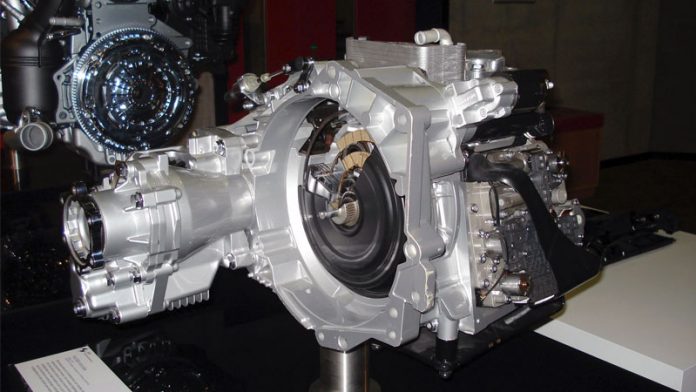Many people consider dual-clutch transmissions to be just as engaging as regular manual transmissions but without any of the downsides. To some extent, that’s true. That’s what helped Audi dominate the Group B rally scene in 1985.
Dual-clutch transmissions are one of the few choices around that allow you to shift on your own and help you feel connected to the car. So, how does it work?
Two Manuals Equal One DCT


Dual-clutch transmissions aren’t all that complicated, at least, conceptually. Design-wise, a dual-clutch transmission is two manual gearboxes combined into one.
One manual gearbox takes care of the odd gears, while the other one takes care of the even gears. Thus, each manual gearbox has all its explicit components, like synchronizers and, more importantly, a clutch.
Seeing how we have two manual transmissions, we have two clutches, hence the dual-clutch transmission name. However, we don’t have two pedals. That’s because the shifts are electronically controlled; thus the clutches take care of themselves.
However, its internal design is a bit more complicated, even if they truly are two manual transmissions stuck together and electronically controlled.
Input and Output Shafts
As we know, transmissions have an input shaft that is connected to the engine and the clutch, and an output shaft, that goes to the wheels. These two manual transmissions, even if it may look like they have the same input shaft, they don’t.
One input shaft is solid, while the other is a hollow shaft that houses the solid one. Thus, they can share the same space and the same rotation axis but rotate at different speeds.
Usually, the odd-geared shaft is solid, while the even-geared shaft is hollow and houses the odd-geared one. This is the core of a dual-clutch transmission.
Furthermore, some particularities depend on the manufacturer and the goal. These two input shafts can have their output shaft or share the same one.
Whatever the design choice may be, once the force reaches the output shaft it will eventually reach the wheels. It all depends on the engine’s power, the platform’s available volume, and the car’s architecture.
Dual-Clutch Transmission Under Load
What makes dual-clutch transmissions special is how fast they can shift and how they can shift under load. Seeing how we have two clutches, whenever we choose to disengage one clutch, the other one can engage at precisely the same time, thus having little to no downtime in between shifts.
This process can be so fast that one clutch doesn’t need to disengage fully so that the second clutch can engage. This can happen in a few tenths of a second.
However, choosing the gear is challenging and is a significant bother for several dual-clutch transmission owners. The car’s computer tries to predict what gear you may need and prepare said gear beforehand to minimize shift times.
If your car guesses the wrong gear, it will take a while until the proper gearshift takes place, resulting in an annoying bog-down and a seeming lack of response. An extreme example would be you trying to upshift while slowing down. This can happen to the most basic of tasks.
Dry and Wet Clutches
Design-wise, they come in two similar variants: dry clutches and wet clutches. The main difference between the two is, apart from the engineering behind building the clutch, how much torque they can handle. Wet clutches can withstand more torque, hence they’re common on powerful sports cars. That’s the case since a wet clutch is covered in a film of oil that provides better heat dissipation, thoroughly needed when engines surpass 500 bhp.
There are also some other nuances, like how a wet clutch has multiple discs, while a dry clutch is a manual transmission clutch, or how these wet clutches need their oil changed occasionally.
Problems With DCTs
A problem with dual-clutch transmissions is that they can be quite finicky. There has been a myriad of issues across the years regarding them.
Volkswagen recalled 1.6 million cars fitted with a dual-clutch transmission in 2013, while Kia had a bunch of issues with their dry 7-speed DCT transmission quite recently. A recall has been issued in South Korea, because the transmission refused to use the odd-geared shaft, hence being stuck in the second, fourth, and sixth.
Moreover, people found the transmission to be harsher than expected, with others experiencing quite a bit of slippage. A faulty software program was the culprit of the gear selection issue, while the jerkiness may be innate to the car or due to manufacturing clearances that push the transmission too much.
Fascinating Dual-Clutch Transmissions
Overall, dual-clutch transmissions are fantastic pieces of machinery built for speed and refinement, and probably the closest thing we will ever get to a regular manual transmission once they are completely phased out.
They also have a unique feature: the fastest shifts you will ever experience. That is when the transmission wants to cooperate.
References
- Orlove, R. (2016, March 12). Watch Audi’s First Double-Clutch Transmission Debut Over 30 Years Ago. https://jalopnik.com/watch-audis-first-double-clutch-transmission-debut-over-1764072236
- Harris, W. (2006, April 6). How Dual-clutch Transmissions Work. HowStuffWorks. https://auto.howstuffworks.com/dual-clutch-transmission.htm
- (2021, August 13). What Are the Benefits of a Wet Clutch vs. A Dry Clutch?. PJ1 Powersports. https://pj1.com/blog/wet-clutch-vs-dry-clutch/
- Lpez, J. A. (2019, October 14). Kia Recall 7-speed DCT in South Korea. Korean Car Blog. https://thekoreancarblog.com/2019/10/14/kia-recall-7-speed-dct-in-south-korea/

